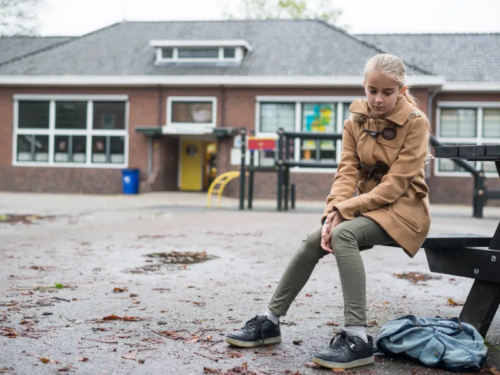
Table of Contents
Trauma-Informed Therapy for Teens: What It Is and Why It Matters

Written By: Sarah duRivage-Jacobs

Clinically Reviewed By: Dr. Don Gasparini
Updated: November 21, 2023
5 min.
Trauma-informed therapy for teens is designed to address the specific needs of young people who have survived trauma.
Learn more about our Clinical Review Process
Table of Contents
Trauma is, unfortunately, quite common among young people: Research shows as many as one in four young people may go through a significantly traumatic experience at some point in their childhood or adolescence. People assigned female at birth and people of color are more likely to go through a potentially traumatic event in childhood, according to studies.
The effects of trauma can be extremely challenging to manage, but healing is possible, especially with trauma-informed care—care that’s designed to address the impact of trauma through trauma-sensitive practices. In this article, we’re explaining what trauma-informed therapy is, what therapeutic modalities may be best for teens who’ve experienced trauma, and how Charlie Health can support teens healing from trauma.

We support teenage survivors
Get trauma-informed therapy with other young people who get it.
What is trauma-informed therapy?
Trauma-informed care can be practiced in many different contexts, from workplaces to schools. Trauma-informed therapy specifically encompasses any trauma-informed approach to psychotherapy designed to treat trauma and conditions like post-traumatic stress disorder (PTSD). This category of therapy hinges on the impact of trauma on overall emotional well-being, day-to-day coping, and helpful versus harmful thoughts and behaviors. The goal is to help clients process, understand, and manage emotions and memories informed by past trauma so they can lead happier, more fulfilling lives.
Trauma-informed care of all kinds (including trauma-informed therapy) seeks to incorporate what’s known as “the four R’s”:
- Realize trauma’s far-reaching impact and possible treatment paths.
- Recognize the signs and symptoms of trauma.
- Respond by fully integrating what we know about trauma into practices.
- Resist re-traumatization of the people being supported.

Are there different types of trauma-informed therapy?
While any mental health clinician can take a trauma-informed approach to providing care, there are several specific therapeutic modalities that experts recommend for treating people who’ve experienced trauma, all of which are variations of cognitive behavioral therapy (CBT).
Cognitive behavioral therapy (CBT) is the gold standard for PTSD. CBT is a form of psychotherapy that aims to help people identify maladaptive patterns of thinking and behavioral responses to curb distressing feelings. Variations and derivatives of CBT that are more focused on trauma responses, emotions, and memories are also strongly recommended for treating PTSD, including cognitive processing therapy, cognitive therapy, and prolonged exposure.
How does trauma-informed therapy for teens work?
Any mental health clinician who works with teens has the opportunity to incorporate a trauma-informed approach and the four R’s of trauma-informed care into all therapeutic modalities. That said, experts and researchers have uplifted specific modalities that are more effective for young people who’ve experienced trauma.
In 2013, the World Health Organization recommended only two treatment options for children and adolescents with PTSD after examining the existing literature: The first was a form of CBT called trauma-focused CBT (TF-CBT), and the second was eye movement desensitization and reprocessing (EMDR) therapy.
Trauma-focused CBT (TF-CBT)
Eye movement desensitization and reprocessing (EMDR)
A specialized form of CBT designed for young people who have experienced trauma, combining CBT with play and family therapy.
Uses one-sided brain stimulation with light or sound to decrease the emotional intensity of trauma.
Trauma-focused CBT (TF-CBT)
Trauma-focused CBT (TF-CBT) was developed in 1996 by psychiatrist Dr. Judith A. Cohen and psychologists Dr. Anthony P. Mannarino and Dr. Esther Deblinger. It’s a kind of CBT designed exclusively for children and adolescents ages 13 to 18 who’ve experienced trauma.
It combines CBT techniques with elements of play and family therapy to address the emotional and behavioral impact of trauma on young people. TF-CBT typically involves collaboration between the child, their family, and a trained therapist to help process and cope with traumatic experiences. These “PRACTICE” components make up TF-CBT:
- Psychoeducational and parenting skills, including learning and skill building for clients and their parents.
- Relaxation techniques like focused breathing and visual imagery.
- Affective expression and regulation, which encompasses managing emotional reactions, identifying and expressing emotions, and self-soothing.
- Cognitive coping and processing, which means understanding how thoughts, feelings, and behaviors connect and correcting inaccurate or distorted thinking.
- Trauma narration and processing, including gradual exposure to the traumatic event through verbal, written, and/or other creative exercises—and the processing of incorrect or maladaptive thinking.
- In-vivo exposure, which is gradual exposure to reminders of the trauma to better manage emotional responses.
- Conjoint parent/child sessions where the family works to support a discussion of the traumatic event and trauma narration.
- Enhancing personal safety and future growth by establishing safety skills, healthy relationship skills, and management skills for future activation of trauma.
Eye movement desensitization and reprocessing (EMDR)
In EMDR therapy, stimulation of one side of the brain at a time, using light or sound, is performed to decrease the emotional intensity associated with a trauma. EMDR therapy was created by psychologist Dr. Francine Shapiro in 1989 as a way to treat trauma, but it wasn’t applied to the youth population until 1999. EMDR typically involves a structured, eight-phase approach to care where the therapist helps the client process and replace negative memories with positive beliefs using guided techniques, ensuring progress and addressing any remaining issues in subsequent sessions.
What can teens get out of trauma-informed therapy?
Trauma-informed therapy can be very helpful for teens who need support managing distressing symptoms related to trauma and PTSD in the following ways:
- Learn more about trauma responses and the impact of trauma.
- Rebuild a sense of internal and external safety.
- Adapt to newly identified triggers and reminders of trauma.
- Develop a toolkit of coping strategies for when triggers and reminders come up.
- Reduce distressing symptoms related to the trauma.
- Process the trauma and narrate their own story.

The authors of a 2018 meta-analysis reviewing the research on TF-CBT and EMDR for children and adolescents who experienced trauma determined that TF-CBT and EMDR are both effective in reducing symptoms, but that TF-CBT may be slightly more effective. A theory for TF-CBT’s minor advantage, according to the study’s authors, is the gradual exposure to trauma. In the study, the effectiveness of TF-CBT and EMDR in treating trauma in adolescents held true regardless of the type of trauma.
Can trauma-informed therapy also help teens with complex trauma?
Complex trauma is repeated exposure to traumatic events. For example, a child or adolescent may have experienced long-term abuse or neglect from a caregiver. The meta-analysis we mentioned in the last section also found that there wasn’t a significant difference in treatment effectiveness between TF-CBT and EMDR for people who experienced one versus multiple traumatic events.
However, the National Child Traumatic Stress Network also recommends a multimodal trauma-informed approach called Integrative Treatment of Complex Trauma for Adolescents (ITCT-A) for complex trauma. ITCT-A combines several therapeutic modalities, including cognitive therapy, exposure therapy, mindfulness, and psychoeducation.
Trauma-informed therapy for teens at Charlie Health
If you or a loved one are struggling with trauma—whether it’s childhood trauma, psychological trauma, or another traumatic experience—Charlie Health is here to help.
Charlie Health’s virtual Intensive Outpatient Program (IOP) offers more than once-weekly support for young people dealing with a range of complex mental health conditions, including trauma. Our program combines group sessions, individual counseling, and family therapy for holistic support. All of our clinicians take a trauma-informed, evidence-based approach to care, practicing a range of therapeutic modalities like cognitive processing therapy and exposure therapy for those dealing with distressing symptoms from past trauma.
Fill out this short form to get started healing today.
References
https://psycnet.apa.org/doiLanding?doi=10.1037%2Fa0028441
https://www.cdc.gov/vitalsigns/aces/index.html
https://www.apa.org/topics/trauma
https://store.samhsa.gov/sites/default/files/d7/priv/sma14-4884.pdf
https://www.apa.org/ptsd-guideline/treatments
https://www.ncbi.nlm.nih.gov/pmc/articles/PMC7163897/
https://www.childwelfare.gov/pubPDFs/trauma.pdf
https://www.ncbi.nlm.nih.gov/pmc/articles/PMC7163897/
https://www.apa.org/ptsd-guideline/treatments/eye-movement-reprocessing
https://www.ncbi.nlm.nih.gov/pmc/articles/PMC7163897/
https://www.nctsn.org/sites/default/files/interventions/itcta_fact_sheet.pdf




